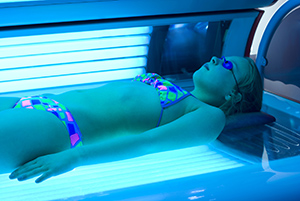AACR Joins With Melanoma Experts to Warn of Dangers from Tanning Beds
Because February is National Cancer Prevention Month and indoor tanning can dramatically increase a person’s skin cancer risk, melanoma experts are posting here and on other sites a message for America’s young people, especially young women – stay out of indoor tanning beds.
“As a doctor, I see many cases of melanoma,” the deadliest form of skin cancer, said Antoni Ribas, MD, PhD, of the UCLA Jonsson Cancer Center. “It breaks my heart to see young people, more commonly young women, with a history of tanning who have developed melanoma, many years before we would normally expect to see it. Indoor tanning using ultraviolet (UV) radiation damages the skin and significantly increases the risk of later developing melanoma.”
Ribas is a leader of a “Dream Team” of top researchers on immunology and immunotherapy funded by Stand Up To Cancer (SU2C), the Cancer Research Institute (CRI), and the Melanoma Research Alliance (MRA). The Dream Team is helping to develop new treatments for malignant melanoma. More than 76,000 cases of melanoma will be diagnosed in the United States this year, and more than 10,000 people are expected to die from the disease.

More than 1.6 million high school students are estimated to use tanning beds every year, with four times as many girls as boys using indoor tanning devices, according to a Centers for Disease Control and Prevention (CDC) study.
According to the American Academy of Dermatology, those who have been exposed to UV radiation from indoor tanning are 59 percent more likely to develop melanoma than those who have never tanned indoors. More than 1.6 million high school students are estimated to use tanning beds every year, with four times as many girls as boys using indoor tanning devices, according to a Centers for Disease Control and Prevention (CDC) study.
“We now have the knowledge on how to reduce the significant health burden of melanoma through prevention,” said Jeffrey E. Gershenwald, MD, surgical oncologist and medical director of the Melanoma and Skin Center of the University of Texas MD Anderson Cancer Center in Houston, and a member of the Joint Scientific Advisory Committee with oversight of another SU2C Dream Team, the SU2C – Melanoma Research Alliance Dream Team. “Avoiding indoor tanning and minimizing overexposure to the sun are two ways we can all reduce melanoma risk. After all, we know that tanned skin is also damaged skin,”Gershenwald said.
More than 20 health and cancer-related organizations, including SU2C, Melanoma Research Alliance, the American Association for Cancer Research, and the American Society of Clinical Oncology, have called for state and federal legislation to prohibit the use of indoor tanning by minors under the age of 18.
“There is clear and compelling scientific evidence that use of tanning devices is associated with an increased incidence of skin cancer including melanoma, basal cell cancer and squamous cell cancer,” says the joint statement. It notes that the World Health Organization’s International Agency for Research on Cancer has classified UV radiation from tanning devices as carcinogenic to humans, in the same category as asbestos, tobacco, and plutonium.
Melanoma rates among young women have soared 50 percent since the 1980s, a trend that has paralleled a rise in the use of tanning salons, according to the National Cancer Institute.
Fourteen states (California, Delaware, Hawaii, Illinois, Louisiana, Massachusetts, Minnesota, Nevada, New Hampshire, North Carolina, Oregon, Texas, Vermont, and Washington) and the District of Columbia currently ban people under 18 from using commercial tanning beds, according to the National Conference of State Legislatures.
In December 2015, the U.S. Food and Drug Administration (FDA) proposed a nationwide ban on the use of commercial indoor tanning facilities by minors (those under 18). A ban is necessary, the agency said, because evidence shows children under 18 are particularly vulnerable to the damaging effects of UV radiation, and the cumulative effects of exposure have been linked to higher incidence of skin cancer.
People over 18 would have to sign a statement that they had been informed of the risks of indoor tanning. The certification would include warnings regarding sunlamp products as well as information regarding the proper use of the devices, the agency said.
Anyone is able to comment on the FDA’s proposed rule until March 21, 2016, at which point the FDA will review the comments and look to issue a final rule.



